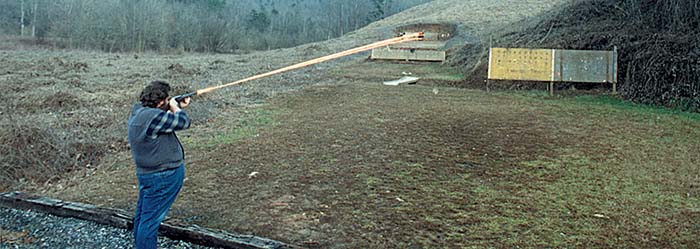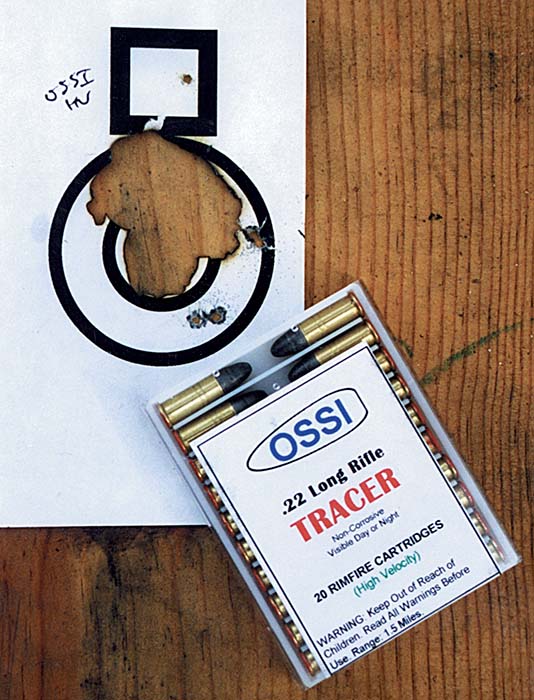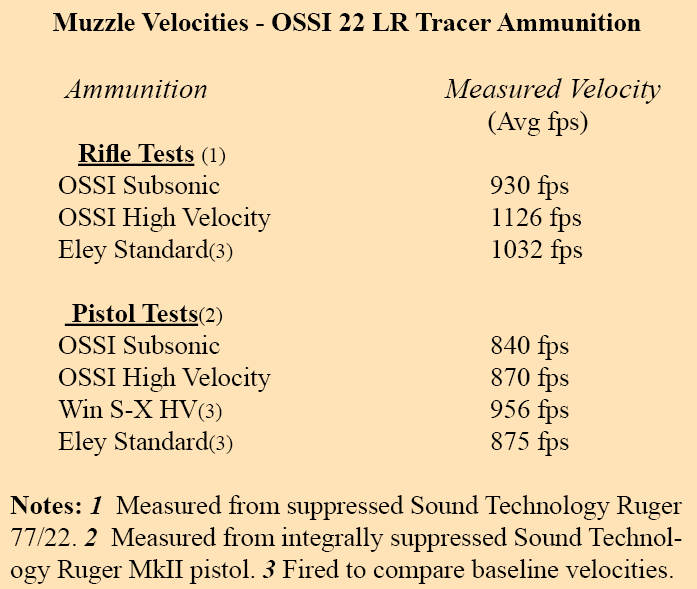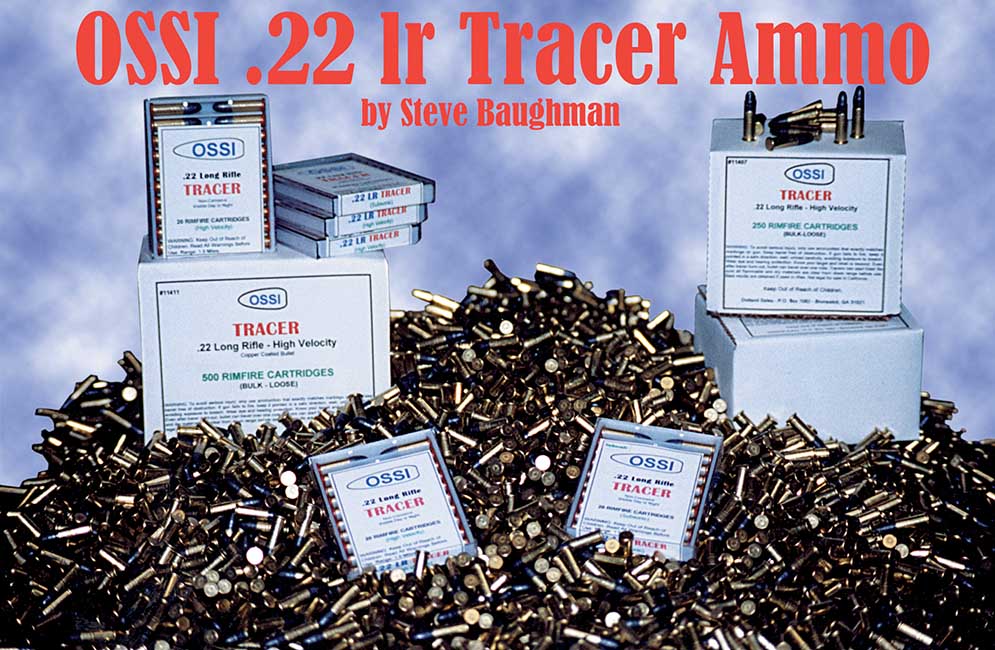By Steve Baughman
The author recently evaluated some 22 LR tracer ammunition for the recreational/sport shooter. Those interested in a fun addition to their small-bore shooting activities might consider the use of tracers. They are a unique accessory for the firing range…..
The .22 LR cartridge is undoubtedly the most popular cartridge in the history of the shooting sports. It has been used to put food on the table, win Olympic shooting events, train all types of shooters, and probably has saved countless lives in one way or the other. The rimfire cartridge is inexpensive, and usually quite reliable. Several machine guns have been built to take advantage of the economics of the little cartridge, and the firearms caliber-conversion market is built around its versatility. Many of us probably remember the first time we were introduced to it which, for most of us, was at a young age. Its low price and noise levels were the perfect combination to learn safety aspects of shooting without hurting the wallet too much. For the suppressor user, its subsonic varieties can provide a new and quieter aspect to target shooting and other uses. Besides being fun, the use of specialty versions of .22 tracer ammo can help in improving marksmanship skills. Tracers allow the shooter to see the projectile on its way to the target. They can also aid in firearm safety since the shooter (and bystanders) can see the effects of ricochets and other unsafe backstop conditions. Bullet strikes are also easily identified. Participants and spectators at any of the Knob Creek shoots are well aware of the use of tracers.
Another one of my favorite aspects of shooting a 22 is using subsonic ammunition and a suppressor for quiet discreet target shooting and plinking. I’ve spent many an hour launching the quiet projectile at tin cans and other plinking materials. One of the recent improvements for the cartridge has been Lapua’s Scoremax load. This cartridge uses a heavier 48gr bullet, which is quite an advancement for the hunting and sport shooting community. It is subsonic as fired from a Ruger 10/22 rifle with a muzzle can. Another interesting improvement, and the main topic of this article, is the use of .22 LR tracer ammo. Unfortunately, it has been rather hard to find good quality .22 tracer ammo since the Gun Control Act of 1968 prohibited the importation of such into this country. Eley of England, and RWS of Germany currently manufacture .22 tracers, but current laws restrict them to law enforcement sales only. There are no major commercial manufacturers in the United States. Winchester produced a .22 LR tracer for the military at one time, but discontinued it when the armed forces dropped the requirements for .22 LR tracer from its inventory.
There are a few custom commercial manufacturers in the U.S. that do produce .22 tracers. Since 1987, Outland Sales and Service, Inc. (OSSI) has manufactured .22 LR tracer ammunition for the general public. The president of Outland, Buddy Singleton, is no stranger to the shooting sports. His background includes small bore competition shooting, and his machine shop background eventually led to his interest in developing reliable tracer ammunition which could be used by the average shooter. We recently tried out a batch of his tracers, and found that they are indeed fun to shoot. OSSI tracer rounds are loaded with a specially designed bullet that contains a pyrotechnic element in the base. The element is ignited by the burning cartridge powder when fired. Similar to the chemicals used in a flare, the ignited element allows the shooter to see the path of the bullet going down range. Outward identification of most tracer ammunition is usually indicated by a painted bullet tip. Instead of a painted bullet tip, OSSI identifies their high velocity tracers with a painted red cartridge base. Their subsonic rounds are also painted red on the bottom, but with a black stripe to differentiate from the HV variety. Contrary to some beliefs, they do not transfer any more heat to the barrel than normal cartridges. They burn for about one second, which allows enough time for the shooter to see the bullet flight. OSSI tracers burn very bright, even in full sunlight. They seemed to be brighter than most I remember seeing at the Knob Creek shoots. I manually lit a pulled bullet, and was really surprised at how bright and intense the element burned. It is a very violent event, one which can somewhat affect accuracy as a trade off. One of the best attributes of using tracers is allowing young and beginning shooters to see the results of ricochets. I really enjoyed shooting them out of a pistol at some tin cans placed 100 yards downrange. The bullet drop is easily compensated for thanks to seeing the bullet’s flight trajectory.

The composition used in a tracer round is usually based on components of magnesium, to provide a bright flame. Various other components, usually strontium nitrate, give the flame a bright red color. Most tracers manufactured today use non-corrosive compounds, but most surplus military tracers made prior to 1954 used chlorates, which are corrosive. Red appears to be the favorite color since it provides a good contrast against most backgrounds and doesn’t spoil one’s natural night vision. The tracer composition is pressed into the bullet cavity under considerable pressure to form a very hard-packed filling, which burns layer by layer. The hard “pressing” process makes the composition more difficult to ignite, and a layer of starter composition is usually used on the base. This is ignited by the propellent flash, and transfers ignition to the tracer composition. It also usually prolongs the onset of the trace to some distance from the gun’s muzzle. The OSSI 22 LR bullet core contains a red tracer element which also contains an igniter element at the bottom base. Several events must occur for the tracer to work. First, the gun’s firing pin ignites the cartridge rim priming which ignites the smokeless powder. Next, the main burn launches the bullet and ignites the element in its base, which in turn, ignites the tracer compound. All this takes a little time, which explains why the bullet is on its way down range before one can actually see the trace. Bullet weight starts out at 38gr, and is reduced to 36gr after burnout. Burnout range is around 150-200 yards for HV, with subsonic loads having a range reduction of about 10%.

Using both manual and automated methods, OSSI takes new .22 ammunition and carefully disassembles each round. Bullets are pulled, and then modified to introduce the tracer element in the base. The lead bullet and tracer material are swaged into bullet form under 50 tons of pressure. Their quality control checks include both static and shooting tests for each lot. Static tests are done to light the tracer element, and to ensure that the burn time is correct. This is critical to a good trace when actually fired from the firearm. Several factors must be maintained to ensure that a good quality tracer is manufactured. Humidity levels during loading and of course, chemical composition must be maintained to within certain limits to produce a quality product.
We fired OSSI tracers with a suppressed Ruger 10/22 (Gemtech Vortex II), a suppressed 77/22 (Sound Technology), and an integrally suppressed MK II pistol (Sound Technology). We also mounted a Tasco NVS470 Generation II night vision scope on the rifle for some nighttime shooting with the tracers. For the nighttime user, the scope really shines in its capability to image tracer rounds over long distances. The low recoil of the rimfire cartridge allows the shooter to actually watch the tracer round drop as it travels downrange, and to compensate for excessive bullet drops encountered past 100 yards. With muzzle velocities running a little less than 1000 fps, bullet drop is fairly excessive at 100 yards and further. We fired several series of shots at distances out to 200 yards, and watched the tracers drop onto the targets with the nightscope. None of the subsonic rounds produced a ballistic crack associated with breaking the sound barrier. Producing an average velocity of 930 fps out of the 77/22 rifle, the quiet rounds were well below the speed of sound (1126 fps @ 68oF) during our tests.
Some safety issues must be adhered to when shooting tracers. Firing into any potentially flammable object or material is obviously not advised. The use of an earthen backstop is also recommended to completely capture the projectile and reduce ricochets. I’ve fired 5.56, M856 penetrator tracer rounds into earthen backstops at 100 yards, and then watched the smoke and burning material come out of the resultant hole for several seconds. When shooting out in open areas, I usually limit their use to very wet and rainy conditions to alleviate some of the safety concerns. We did set one of our paper targets on fire while shooting the pistol. My advice is to have fun, be smart, and be careful. Some states such as California and New York do restrict the use of tracers, so one should check with local and state laws before use. I checked into my state’s regulations, and found that there are no restrictions for either hunting or general shooting. However, the use of night vision scopes is not permitted for hunting protected game animals. The only exceptions were when used to hunt varmints, or other undesirable and unprotected wildlife.
Muzzle velocities were recorded as fired from a Ruger 77/22 and an integrally suppressed MkII pistol suppressed by Mark White of Sound Technology. The pistol has always liked high velocity rounds, with CCI Mini Mag + V’s as the overall favorite for reliable and accurate functioning. Winchester HV Super-X ammunition sometimes failed to reliably cycle this pistol’s action, so the higher velocity rounds have really worked well. Obviously, OSSI subsonic’s did not cycle the pistol’s action, which was consistent with our past experience using other subsonic loadings. We compensated for this by holding one thumb over the bolt while firing, and manually cycling the guns action. No cycling problems were encountered with the 77/22 rifle. Tracers are meant to be fun to shoot, and our intent was not to do an exhaustive evaluation. Tracers are not universally known for match grade accuracy, and we were producing about 1.5 inch groups at 25 feet with the pistol. For comparison, Winchester Super-X high velocity rounds were producing 1 inch groups at this same distance. Unfortunately, we did not have any full auto’s on hand to test out their performance in that mode. I would suspect that Outland’s HV tracer rounds would reliably function in any of the .22 LR machine guns (and conversion units) available. The ultimate would probably be a fully loaded drum on a American-180 buzz saw, shooting tracers out to about 150 yards at night. It would make for some great video. OSSI subsonic did not produce any ballistic crack associated with breaking the sound barrier, which was validated by our velocity readings. The HV rounds were also generating subsonic velocities out of the suppressed pistol, and was also producing a quiet report.
OSSI is also introducing a 22 magnum tracer. They currently provide a 22 magnum subsonic load (not tracer), and a Nosler ballistic tip bullet which might be of interest to the varmint hunter or rancher. Their .22 LR tracers are offered in quantities of 20 round plastic boxes, and 250 and 500 round loose (bulk) packed. Discounts are offered for dealers and law enforcement sales. If you’re into 22’s and NFA firearms, OSSI tracers can help revive the fun in shooting the old reliable and utilitarian cartridge.

Source:
Outland Sales
P.O. Box 1082
Brunswick, GA 31521-1082
| This article first appeared in Small Arms Review V1N7 (April 1998) |











